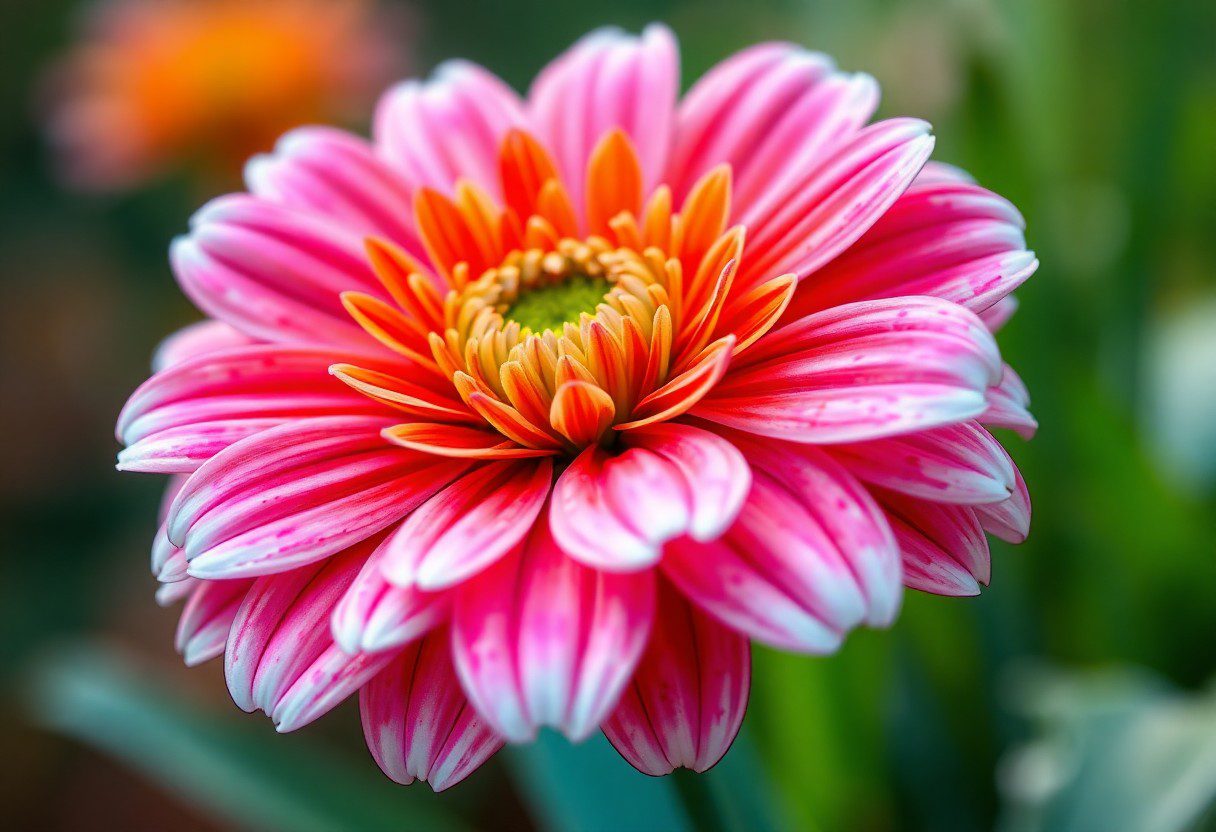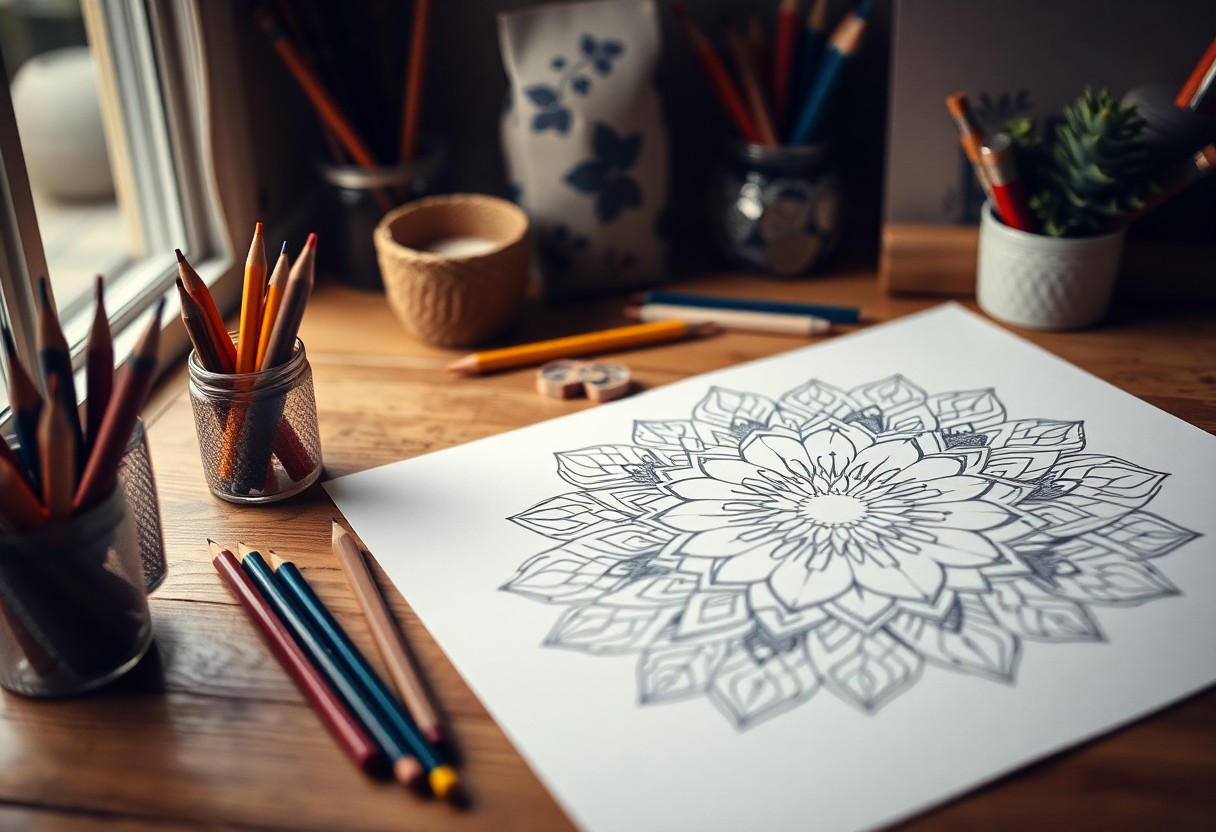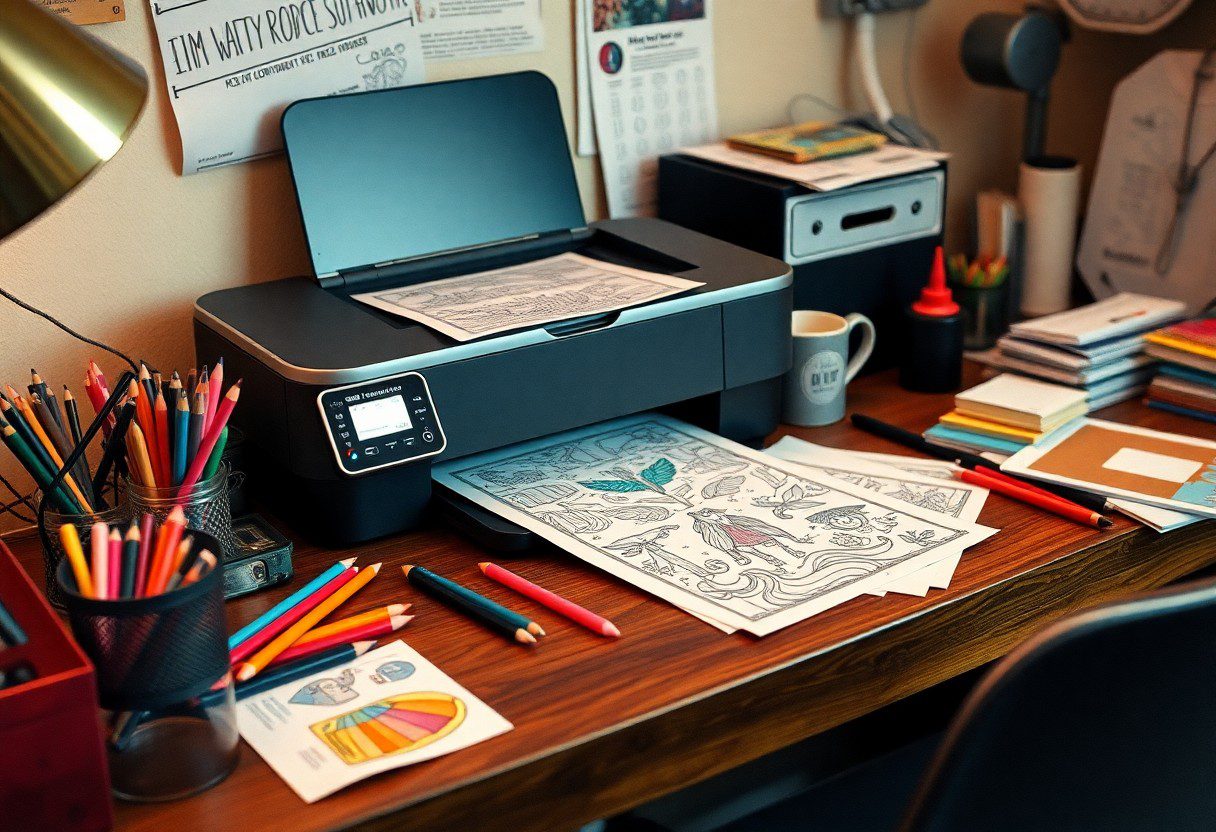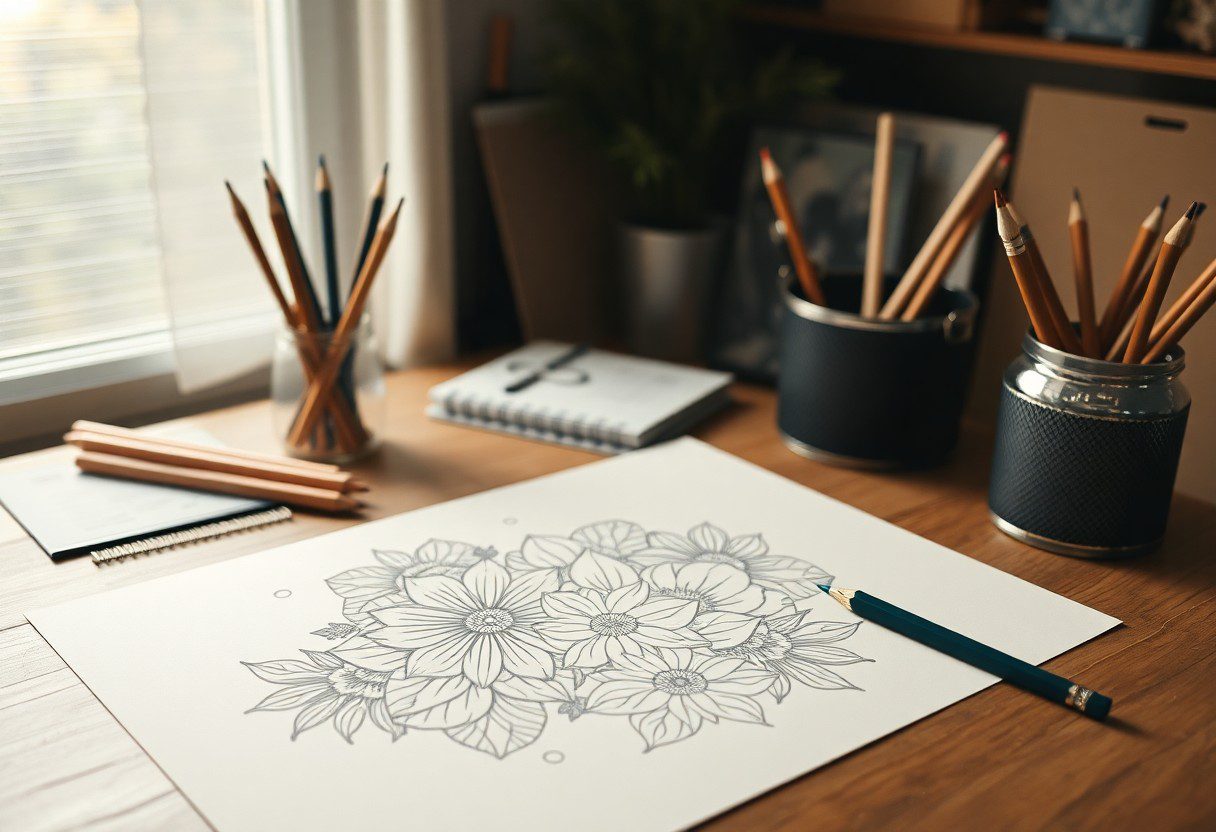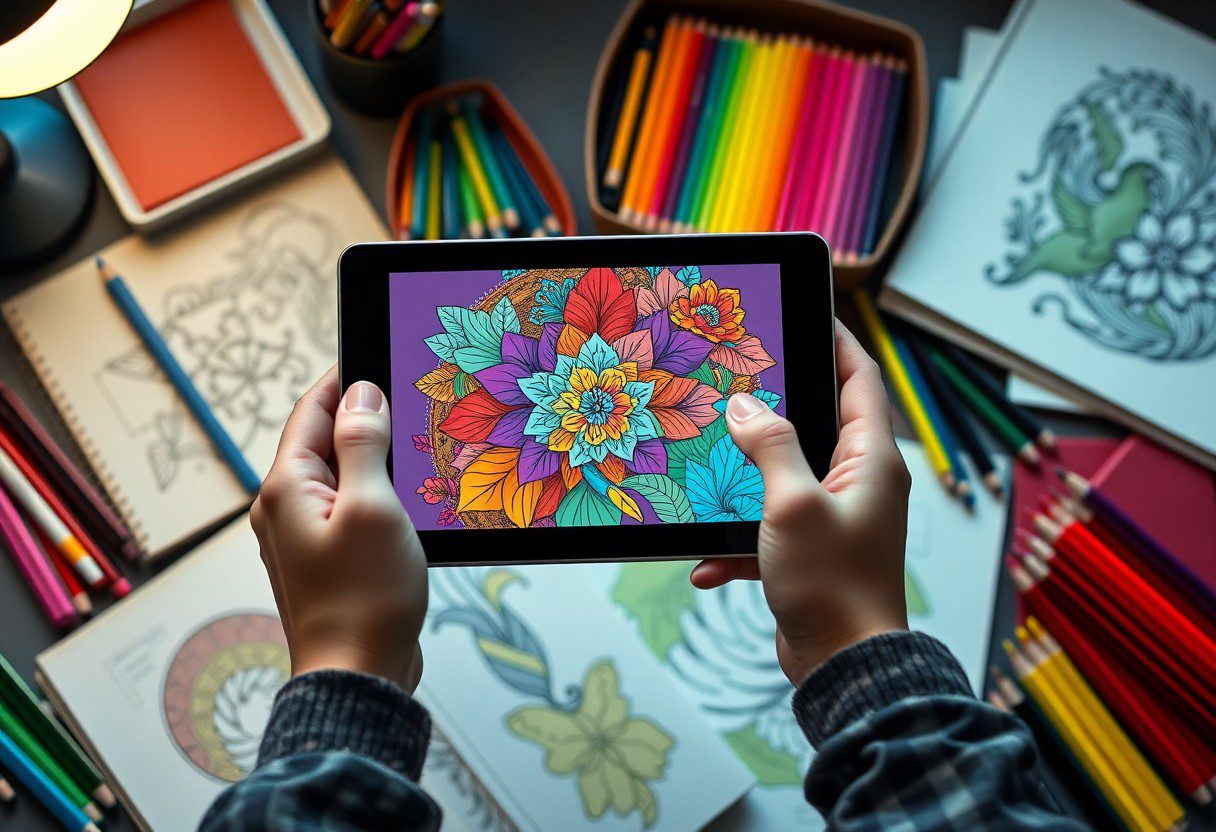This guide will help you create your own unique coloring page, allowing you to express your creativity while providing others with a fun activity. By following a step-by-step approach, you can transform simple shapes into complex designs that appeal to all ages. Utilize various art supplies and techniques to enhance your work, making it as fun and engaging as possible. Whether you’re drawing for relaxation or to share with friends, this process will equip you with the skills to produce stunning coloring pages.
Essential Materials and Setup
For creating a coloring page, you need to gather a few important materials to ensure your drawing experience is enjoyable and productive. Start by choosing a comfortable workspace that is well-lit, providing you with ample room to spread out your supplies. Make sure you have a sturdy desk or table where you can keep your drawing tools and paper organized. A clean and quiet environment allows for better focus, enhancing your creativity as you begin on your coloring page journey.
Required Drawing Tools
Setup your drawing adventure with the appropriate tools, including graphite pencils for sketching, fine-liners or markers for outlining, and erasers for correcting any mistakes. You might also consider colored pencils or markers for adding vibrant details later on. Having a range of tools at your disposal allows you to experiment with different techniques and styles, ultimately leading to a more dynamic and engaging coloring page.
Choosing the Right Paper
An important aspect of your drawing setup is choosing the right paper, as it can significantly impact the final appearance of your coloring page. You’ll want to opt for a heavier-weight paper that can handle various mediums without warping or tearing. Look for smooth paper that allows for easy pencil strokes and crisp lines, enhancing the overall quality of your designs.
Understanding the paper’s weight and texture is vital to achieving the best results. For line drawings, aim for papers that are at least 200 gsm to ensure durability. If you plan to use markers or watercolor, a thicker paper can help avoid bleed-through and maintain your artwork’s integrity. Consider your coloring methods and opt for papers specifically designed for those mediums, enhancing your experience and ensuring a more professional finish to your coloring page.
Planning Your Design
The key to creating an engaging coloring page lies in the planning phase. Take the time to think through your design elements and how they will come together visually. Consider the complexity of your illustrations and the age group of your audience. Planning will help you create a cohesive design that not only looks appealing but also provides an enjoyable coloring experience.
Selecting a Theme
Your choice of theme sets the foundation for your coloring page. Whether you prefer nature, fantasy, or abstract designs, select a theme that excites you and will resonate with your audience. Think about popular trends or personal interests that can bring your design to life and inspire creativity when coloring.
Sketching Basic Shapes
There’s no need to jump straight into detailed drawing; instead, focus on sketching basic shapes that form the backbone of your design. Start with simple circles, squares, and triangles to outline the primary structure of your illustration. This method provides a strong foundation and allows for easier adjustments as you build your composition.
This initial step is important because it helps you establish proportions and placement without overwhelming yourself with details. Use light strokes to experiment with different shapes and layouts, making it easier to erase and modify as needed. By focusing on the basic shapes, you create a solid framework for your design that supports future refinement and detail work, steering you clear of potential pitfalls like overcrowding or poor composition.
Creating the Main Outline
There’s no better way to start your coloring page than by creating a strong main outline. This outline serves as the framework for your drawing, helping you visualize and organize the elements you want to include. Begin with simple shapes to guide your composition, ensuring you have a solid foundation that can be refined later. As you sketch, focus on balance and symmetry to create an inviting design for your audience.
Drawing Clean Lines
Creating clean lines is important for a polished coloring page. Use a sharp pencil or fine-tip pen to sketch your outline, keeping your hand steady for smooth strokes. Avoid pressure variations that can create uneven thickness, as consistency is key. If needed, utilize a ruler for straight edges and templates for intricate shapes. The cleaner your lines, the more enjoyable your coloring page will be for others!
Managing Proportions
Proportions play a significant role in the overall appeal of your coloring page. A well-proportioned drawing ensures that each element relates harmoniously to one another, making it visually satisfying.
For instance, you might want to use the grid method or reference images to help you gauge the sizes of different elements accurately. This approach aids you in understanding how various parts of your drawing, such as the head, arms, and body, interact and fit together. By focusing on the relative size and placement of each component, you can enhance the cohesiveness of your design, leading to a more engaging coloring experience.
Adding Details and Patterns
After establishing the basic outlines of your coloring page, it’s time to infuse it with personality by adding intricate details and unique patterns. These elements not only enhance visual interest but also guide the coloring choices for anyone using your artwork. Think about including whimsical motifs such as swirls, dots, and shapes that can give each section a distinctive feel, encouraging exploration and creativity in the coloring experience.
Incorporating Textures
Some effective ways to enhance your page are by incorporating textures that can evoke different sensations. Consider using lines, cross-hatching, or stippling to imitate materials like fur, wood, or fabric. This not only creates depth but also invites colorists to engage with the piece more thoughtfully, as they decide how to fill in these textured areas.
Balancing Empty Spaces
You want to achieve a harmonious composition, so balancing empty spaces is crucial to a well-designed coloring page. Strategically leaving some areas open allows the artist to have room for creativity while preventing the design from becoming crowded. Ensuring that each element relates to the others can create a more inviting and engaging coloring experience.
Patterns can serve as a backbone for balancing these spaces. By interspersing detailed areas with larger, empty segments, you can guide the viewer’s eye throughout the page. This approach allows colorists to undertake the creative process without feeling overwhelmed. Make sure that the spacing feels intentional, leading to a pleasant flow rather than chaotic clustering. A good balance of intricate details and open areas promotes an engaging interaction with the artwork, ensuring it remains enjoyable and approachable.
Design Considerations
To create an engaging coloring page, you need to focus on several design considerations. Think about the overall theme, the target audience, and how the image will inspire creativity. The use of different shapes, patterns, and elements can enhance visual interest, while ensuring clarity allows for easier coloring. Additionally, consider the printing format and how it will appear in both digital and physical forms to ensure a positive experience for anyone using your coloring page.
Age-Appropriate Elements
Considerations regarding age-appropriate elements are vital in your design process. You want to ensure that the imagery resonates with the intended age group, incorporating familiar symbols and themes. Younger audiences may appreciate more simplistic and playful designs, while older kids and adults might prefer intricate patterns that challenge their skills.
Complexity Levels
An understanding of complexity levels in your coloring page will help cater to a wider audience. Balancing intricate details with larger open spaces allows for varying skill levels, ensuring that every user can enjoy the activity. This approach not only accommodates beginners who may feel overwhelmed by too much detail but also provides a rewarding challenge for experienced colorists.
The complexity of your coloring page should be adjusted to match the target audience’s abilities. For young children, opting for larger shapes with broad areas for coloring keeps them engaged without causing frustration. Conversely, for teens and adults, more elaborate designs featuring finer lines and intricate patterns enrich the coloring experience. By offering a variety of complexity levels, your coloring page invites users to connect with your art while also challenging their creativity.
Technical Tips
Keep your illustrations clear and engaging by adhering to certain technical principles. Consider the following:
- Use varied line weights to create depth.
- Avoid overly complex details that may confuse colorists.
- Ensure your composition flows naturally to lead the eye.
- Utilize negative space effectively to enhance balance.
Thou will find that following these guidelines enhances your coloring page’s appeal.
Line Weight Guidelines
For effective illustrations, varying line weight is vital. Thicker lines typically draw attention to key elements, while thinner lines can add subtlety to details. Ensure the weight distinction supports the visual hierarchy and maintains clarity throughout your design.
Space Distribution
You should pay careful attention to space distribution when creating your coloring page. Balancing areas of detail and open space ensures that the viewer’s eye can navigate your artwork effortlessly.
Line spacing and placement play vital roles in achieving an effective design. While you may feel tempted to fill every space with intricate details, understand that negative space is your ally; overcrowding can diminish the overall aesthetic. By strategically distributing elements, you create a harmonious balance that allows colorists to enjoy the experience while preventing any part from overwhelming the other. Prioritize flow and contrast to guide their hand as they fill your creation with color.
Summing up
So, now that you know the steps to draw a coloring page, you can unleash your creativity and express yourself through art. Start by choosing a theme and gathering your materials, then sketch your design lightly and refine it with bold outlines. Don’t forget to consider patterns and details that will make your page engaging. Lastly, you can leave it blank for others to color or add your own colored details. With practice, your coloring pages will become a delightful showcase of your artistic vision. As you create more intricate designs, you might also explore different coloring techniques to elevate your work. If you’re interested in digital art, learning how to color in Procreate can open up a whole new world of possibilities, allowing you to experiment with layers, textures, and vibrant color palettes. Remember, the key is to have fun and let your imagination guide you, whether you’re working on paper or digitally.
Q: What materials do I need to create a coloring page?
A: To create a coloring page, you will need basic drawing materials such as paper (preferably thicker to withstand coloring), pencils for sketching, black pens or markers for outlining, and optionally, an eraser for corrections. If you prefer digital drawing, you’ll need a drawing tablet or computer software with drawing capabilities. Having access to coloring tools like crayons, colored pencils, or markers can also help you visualize your page once it’s finished.
Q: What steps should I follow to draw a coloring page?
A: Start by sketching your ideas lightly on paper. Consider the theme of your coloring page, such as animals, landscapes, or abstract designs. Once you have a rough sketch, refine the details. After you are satisfied with your drawing, go over it with a black pen or marker to create bold outlines. Ensure all elements are enclosed, making it easier to color later. Finally, erase any remaining pencil lines to clean up your page, and you can scan or photograph it if you wish to share it digitally.
Q: How can I make my coloring page appealing?
A: To enhance the visual appeal of your coloring page, incorporate a variety of patterns and textures throughout your design. Consider using repetition and symmetry to create a balanced composition. Adding elements like flowers, geometric shapes, or whimsical characters can also attract attention. Ensure there are both large and intricate areas for coloring, providing options for both beginners and advanced colorists. Finally, leaving some blank spaces can encourage creativity as users can add their own elements or colors.
